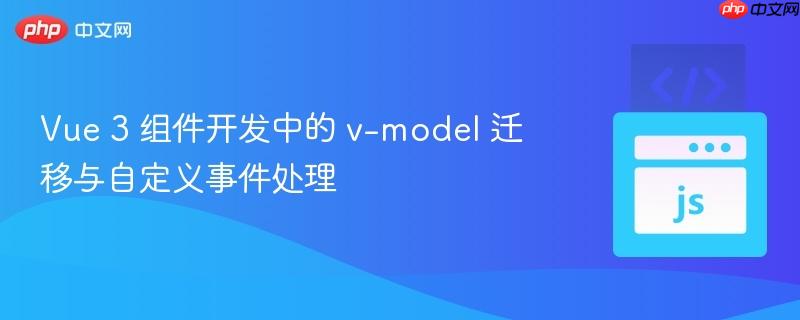
在 vue.js 应用程序开发中,v-model 指令是实现组件双向数据绑定的强大工具,它极大地简化了表单输入和自定义组件状态同步的逻辑。然而,随着 vue 3 的发布,v-model 的底层实现机制发生了显著变化,这对于从 vue 2 迁移或开发新的 vue 3 组件的开发者来说是一个重要的知识点。理解这些变化不仅能解决迁移中遇到的问题,还能帮助开发者更好地利用 vue 3 的新特性。
在 Vue 2 中,v-model 指令在组件上使用时,本质上是一个语法糖,它等价于同时进行以下两项操作:
这意味着,当你在父组件中使用
Vue 2 自定义组件示例:
<!-- MyCustomInput.vue (Vue 2) -->
<template>
<input
:value="value"
@input="$emit('input', $event.target.value)"
placeholder="请输入内容"
/>
</template>
<script>
export default {
props: ['value'] // 接收名为 'value' 的 prop
};
</script>父组件中使用 v-model:
立即学习“前端免费学习笔记(深入)”;
<!-- ParentComponent.vue (Vue 2) -->
<template>
<div>
<MyCustomInput v-model="message" />
<p>当前消息: {{ message }}</p>
</div>
</template>
<script>
import MyCustomInput from './MyCustomInput.vue';
export default {
components: { MyCustomInput },
data() {
return {
message: 'Hello Vue 2'
};
}
};
</script>Vue 3 对 v-model 进行了改进,旨在提供更清晰的语义和更强大的功能,尤其是支持在同一个组件上绑定多个 v-model。在 Vue 3 中,v-model 的默认行为发生了改变:
因此,
Vue 3 自定义组件示例(Options API):
<!-- MyCustomInput.vue (Vue 3) -->
<template>
<input
:value="modelValue"
@input="$emit('update:modelValue', $event.target.value)"
placeholder="请输入内容"
/>
</template>
<script>
export default {
props: ['modelValue'] // 接收名为 'modelValue' 的 prop
};
</script>Vue 3 自定义组件示例(Composition API 和
<!-- MyCustomInput.vue (Vue 3, Composition API) -->
<script setup>
import { defineProps, defineEmits } from 'vue';
// 声明接收 modelValue prop
const props = defineProps({
modelValue: {
type: String,
default: ''
}
});
// 声明触发 update:modelValue 事件
const emit = defineEmits(['update:modelValue']);
// 处理输入事件,并触发 update:modelValue 事件
const handleInput = (event) => {
emit('update:modelValue', event.target.value);
};
</script>
<template>
<input
:value="props.modelValue"
@input="handleInput"
placeholder="请输入内容"
/>
</template>父组件中使用 v-model:
立即学习“前端免费学习笔记(深入)”;
<!-- ParentComponent.vue (Vue 3) -->
<template>
<div>
<MyCustomInput v-model="message" />
<p>当前消息: {{ message }}</p>
</div>
</template>
<script>
import MyCustomInput from './MyCustomInput.vue';
export default {
components: { MyCustomInput },
data() {
return {
message: 'Hello Vue 3'
};
}
};
</script>针对 Vue 2 中使用 value prop 和 input 事件的自定义组件,迁移到 Vue 3 需要以下关键步骤:
以原始问题中提到的 FilterPanel 组件为例,其内部使用了 this.$emit('input', ...) 并且依赖 this.value。在迁移到 Vue 3 后,this.value 变得 undefined 是预期的,因为父组件现在通过 modelValue prop 传递数据。
原始 Vue 2 风格的 emit 示例:
// 在 Vue 2 组件 methods 中
this.$emit('input', { ...this.value, ...qFields });
this.$emit('input', { ...this.value, [this.field]: this.text });
this.$emit('input', omit(this.value, key));迁移到 Vue 3 后的 emit 示例:
假设 FilterPanel 组件的 props 已经从 ['value'] 更新为 ['modelValue'],并且所有对 this.value 的内部引用都已更改为 this.modelValue。那么,对应的 emit 调用应修改为:
// 在 Vue 3 组件 methods 中
this.$emit('update:modelValue', { ...this.modelValue, ...qFields });
this.$emit('update:modelValue', { ...this.modelValue, [this.field]: this.text });
this.$emit('update:modelValue', omit(this.modelValue, key));这里的 qFields、omit() 函数和 key 参数的逻辑保持不变,关键在于 prop 名称 (modelValue) 和事件名称 (update:modelValue) 的正确替换。
从 Vue 2 迁移到 Vue 3 时,v-model 机制的改变是一个核心且重要的环节。理解 value prop 到 modelValue prop、input 事件到 update:modelValue 事件的转变,是确保自定义组件在新版本中正常工作的关键。通过遵循上述迁移步骤和最佳实践,开发者可以顺利地将现有组件升级到 Vue 3,并充分利用其带来的新特性和改进。正确处理这些变化不仅能解决组件功能失效的问题,还能使代码更加符合 Vue 3 的设计理念,提升项目的可维护性和可扩展性。
以上就是Vue 3 组件开发中的 v-model 迁移与自定义事件处理的详细内容,更多请关注php中文网其它相关文章!

每个人都需要一台速度更快、更稳定的 PC。随着时间的推移,垃圾文件、旧注册表数据和不必要的后台进程会占用资源并降低性能。幸运的是,许多工具可以让 Windows 保持平稳运行。

Copyright 2014-2025 https://www.php.cn/ All Rights Reserved | php.cn | 湘ICP备2023035733号